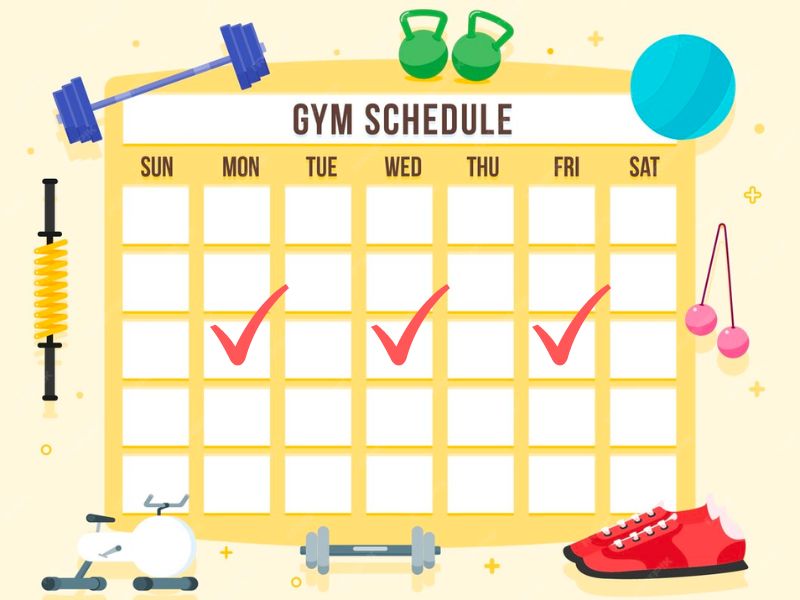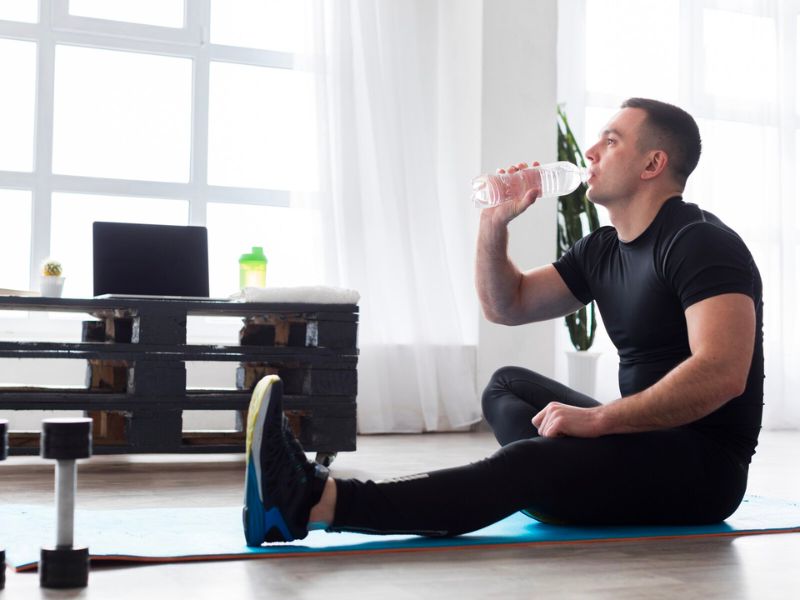Did you know that nearly 60% of adults in the United States report not engaging in any regular physical activity, according to a recent study published in the Centers for Disease Control and Prevention (CDC) (*).
If you’re one of those individuals looking to embark on a fitness journey, strength training can be a powerful tool for achieving your goals, whether it’s building muscle, improving overall fitness, or even managing weight loss.
One of the most common questions beginners have is, “How often should I train with weights?” The answer, however, isn’t a one-size-fits-all solution.
This article delves into the optimal strength training frequency for beginners, explores key considerations, and equips you with the knowledge to build a sustainable and effective routine.
How Often to Strength Train as a Beginner?

One of the most common questions beginners have is, “how many times a week should I strength train for weight loss?” The answer depends on your specific goals and fitness level:
- Maintaining Fitness: Aim for 2 strength training sessions per week, targeting major muscle groups (legs, core, chest, back, shoulders). This helps maintain your current fitness level and lays the foundation for future progress. A 2018 meta-analysis published in the journal Sports Medicine concluded that even low-volume resistance training (1-2 sessions per week) can be effective (*).
- Building Muscle: Aim for 3 strength training sessions per week. A 2017 study in the Journal of Strength and Conditioning Research found that 3 sessions were more effective than 1-2 sessions (*). Remember, prioritize rest days. The American College of Sports Medicine (ACSM) recommends at least one day of rest between sessions for muscle growth (*).
Beginner Considerations:
- Can beginners train strength train every other day? : While possible, starting with 2-3 sessions per week with proper rest days is generally recommended for beginners to allow for adaptation and recovery.
- How often should beginners’ strength train to see results? : Consistency is key. Aim for regular strength training, even if it’s just 2-3 times per week. You’ll gradually see improvements in strength, endurance, and potentially weight loss over time.
Getting Started: Embarking on Your Strength Training Journey

Starting a new exercise routine can feel like a daunting mountain to climb, but it doesn’t have to be. Let’s break it down into manageable steps, guided by research and expert advice, to help you embark on a successful strength training journey.
- Begin with manageable workouts: The National Strength and Conditioning Association (NSCA) recommends starting with 20-minute sessions, 2-3 times per week (*). This helps prevent burnout and allows your body to adjust to the new demands. Think of it as building a strong foundation before adding more weight or complexity.
- Embrace the power of simplicity: Before diving into the world of weights and equipment, utilize the power of bodyweight exercises like squats, lunges, push-ups, and planks.
- Seek guidance if needed: Feeling lost or unsure about proper form? Don’t hesitate to consult a certified personal trainer or gym’s general gym trainer. A trainer can guide you through exercises, ensure you’re performing them correctly, and answer any questions you might have.
- Schedule strategically for success: Consider morning workouts for a burst of energy and increased willpower. Starting your day with exercise can set a positive tone and help you stay on track with your goals.
- Make it enjoyable, not a chore: Pair your workouts with activities you find fun and engaging. Put on some upbeat music, listen to your favorite podcast, or find a workout buddy to keep you motivated. Fitness expert Felicia Romero suggests incorporating activities you enjoy making the experience more rewarding.
- Dress comfortably for optimal performance: Wear clothes that allow for free movement and make you feel good. Many experts recommend choosing comfortable clothing that doesn’t restrict your movement or make you feel self-conscious. Feeling good in your workout clothes can boost your confidence and motivation.
- Be kind to yourself: We all miss sessions sometimes. Don’t beat yourself up – focus on long-term consistency, not perfection, as advised by certified trainer Michelle Elkins. Remember, progress takes time and dedication. Celebrate your achievements, big and small, and focus on building a sustainable routine.
Building a Sustainable Routine: Consistency is Key

Creating a sustainable routine is crucial for making strength training a habit and reaping the long-term benefits. Here are some key elements:
- Detailed instructions and modifications: The American Council on Exercise (ACE) emphasizes the importance of clear instructions and modifications for different fitness levels. This ensures everyone can participate safely and effectively, regardless of their prior experience.
- Warm-up and cool-down: Never skip these crucial phases, a proper warm-up prepares your body for exercise by increasing blood flow and muscle temperature, while a cool-down helps your body recover and prevents stiffness.
- Progression plan: As you get stronger, gradually increase the difficulty of your workouts to keep challenging your muscles and promoting further progress. This concept, known as progressive overload, can involve increasing the number of sets, repetitions, or the weight you lift over time. By progressively overloading, you force your muscles to adapt and continue building strength.
- Alternative exercises: Have a collection of alternative exercises in your back pocket. As the quote says “Nothing.. Fits for All”, this concept also applies to the fitness industry. Let’s say the dumbbell curl fits best for A, whereas barbell curl fits best for B. Also, to find out this best fit you need to exercise these exercises by yourself and check while your body “how it reacts”.
- Nutritional advice: Fuel your body for success. Focus on a balanced diet rich in protein, complex carbohydrates, and healthy fats. Registered dietitian Colleen Kenny emphasizes the importance of proper nutrition for muscle building and recovery (*).
Also Read:
Strength Training for Your Mental Well-being: Beyond the Physical

The benefits of strength training go far beyond just physical gain. Studies in the journal Depression and Anxiety have shown its positive impact on mental health by:
- Reducing stress: Strength training effectively reduces stress hormones and improves feelings of calmness, as evidenced by research in the Journal of Applied Physiology. By focusing on your workout, you can temporarily escape daily stressors and promote relaxation.
- Boosting mood: Engaging in physical activity like strength training releases endorphins, known as the body’s natural feel-good chemicals. This leads to increased happiness and reduced symptoms of depression and anxiety, as supported by the Mayo Clinic.
- Improving self-confidence: Witnessing the progress you make in strength training can significantly boost your self-confidence. Licensed professional counselor Amy Morin notes that this newfound confidence can empower you in other areas of life, helping you tackle challenges and pursue your goals with a more positive outlook.
Remember, strength training is a journey, not a destination. Enjoy the process, celebrate your achievements, and enjoy the journey to becoming a stronger and healthier version of yourself.
Sample Beginner Workout Routine:

Now that you’re equipped with the knowledge and motivation to begin, here’s a sample beginner workout routine:
Warm-up (5 minutes):
- Light cardio (jumping jacks, jogging in place)
- Dynamic stretches (arm circles, leg swings, torso twists)
Workout (20-30 minutes):
Monday & Wednesday:
- Squats: 3 sets of 10-12 repetitions (modify by sitting on a chair if needed)
- Push-ups (modified or regular): 3 sets of as many repetitions as possible (start on your knees if full push-ups are challenging)
- Lunges: 3 sets of 10-12 repetitions per leg
- Plank: 3 sets of 30-60 seconds hold
Tuesday & Thursday:
- Wall sits: 3 sets of 30-60 seconds hold
- Single-leg Romanian Deadlifts: 3 sets of 10-12 repetitions per leg (stand tall, hinge at the hips, reach one leg back while maintaining a flat back, keeping the other leg slightly bent)
- Side plank: 3 sets of 30-60 seconds hold per side
- Bird-dogs: 3 sets of 10-12 repetitions per side
Cool-down (5 minutes):
- Static stretches (hold each stretch for 15-30 seconds) focusing on major muscle groups used during the workout (quads, hamstrings, glutes, chest, back, shoulders)
Conquering Common Beginner Challenges with Strength Training:

Imagine Sarah, a busy professional who has always felt self-conscious about her physique. She’s intimidated by the weight room and unsure where to begin. Regular strength training can empower Sarah to overcome these challenges:
- Lack of confidence: As Sarah progresses with her strength training routine, witnessing her increased strength and endurance can significantly boost her self-confidence. This newfound confidence can translate into other areas of her life, empowering her to take on challenges and pursue her goals.
- Time constraints: Even with a busy schedule, Sarah can incorporate short, effective strength training sessions into her routine. Starting with 20-minute workouts, 2-3 times per week, is manageable and can be gradually increased as her fitness level improves.
- Limited equipment: Sarah can utilize bodyweight exercises like squats, lunges, push-ups, and planks to build strength without needing any equipment. This makes strength training accessible and convenient, even for those without access to a gym.
Conclusion
In conclusion, strength training offers a multitude of benefits for beginners, ranging from building muscle and improving fitness to boosting mental well-being.
This article has demystified the question of “how often should I train?” by providing evidence-based recommendations and addressing common concerns.
Remember, consistency is key, and starting with 2-3 sessions per week is a great way to establish a sustainable routine and embark on your journey to becoming a stronger, healthier you.
So, ditch the intimidation, embrace the process, and celebrate your achievements along the way.


Simply wish to say your article is as amazing The clearness in your post is just nice and i could assume youre an expert on this subject Well with your permission let me to grab your feed to keep updated with forthcoming post Thanks a million and please carry on the gratifying work